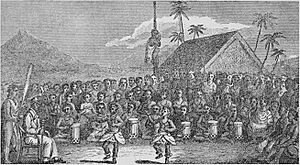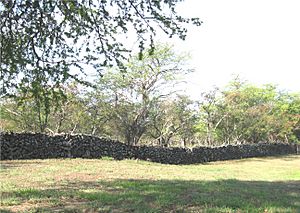Kuakini facts for kids
Quick facts for kids John Adams Kuakini |
|||||
|---|---|---|---|---|---|
| Royal Governor of Hawaiʻi Island and Oʻahu | |||||

An 1822 sketch by William Ellis
|
|||||
| Born | c. 1789 | ||||
| Died | December 9, 1844 Kailua-Kona |
||||
| Spouse | High Chiefess Keoua High Chiefess Haʻaheo |
||||
| Issue | High Chief Keoua High Chiefess Kamānele |
||||
|
|||||
| Father | Keʻeaumoku Pāpaiahiahi | ||||
| Mother | NāmāhānaʻiʻKaleleokalani | ||||
John Adams Kiʻiapalaoku Kuakini (born around 1789, died 1844) was a very important leader in the early days of the Hawaiian Kingdom. He was a trusted adviser to Kamehameha I, the first king of Hawaii. Kuakini helped build many important things and made big changes, especially in the Kona area of Hawaii Island.
Contents
Early Life and Family
Growing Up in Hawaii

John Adams Kuakini was born around 1789. His birth name was Kaluaikonahale. His father was Keʻeaumoku Pāpaiahiahi, a powerful noble, or aliʻi, from Hawaii Island. His mother was NāmāhānaʻiʻKaleleokalani. She was the widow queen and half-sister of the late king of Maui.
Kuakini's father, Keʻeaumoku, had to flee from King Kahekili II of Maui. His family moved to Hana, then back to Hawaii Island. They lived near Kahaluʻu Bay.
Important Siblings
Kuakini was the youngest of four very important siblings. His sisters were Queen Kaʻahumanu, who was King Kamehameha's favorite wife. She later became the powerful Kuhina nui, a kind of prime minister. His other sisters were Kalākua Kaheiheimālie and Namahana-o-Piʻia, who were also queens of Kamehameha. His brother was George Cox Kahekili Keʻeaumoku, who later became the Governor of Maui.
Kuakini's father played a big role in helping Kamehameha I become king. He helped Kamehameha win the Battle of Mokuʻōhai in 1782.
Choosing a New Name
When Christianity came to Hawaii, people were encouraged to take British or American names. Kuakini chose the name John Adams. He picked it after John Quincy Adams, who was the U.S. president at that time. This showed his royal style and how he adopted some customs from the U.S. and Europe.
Physical Appearance
As a young man, Kuakini was very good at sports, like canoeing. Like many Hawaiian royals, he was very tall and strong. A visitor in 1819 said he was about 6 feet 3 inches tall. Later in his life, he was said to weigh over 400 pounds.
Marriage and Children
Kuakini married two women: Keouawahine and Kaniuʻopiohaʻaheo (also known as Haʻaheo). With Keouawahine, he had a son named Keoua, who sadly died as a baby. With Haʻaheo, he had a daughter named Mele Kaʻauʻamoku o Kamānele (1814–1834). Kamānele was considered a possible future wife for King Kamehameha III, but she passed away when she was young. The king later married Kalama.
Royal Governor of Hawaii
Expanding Influence
In 1820, the main government of the Kingdom moved to Lahaina. This made Kuakini's power on Hawaii Island grow. He became the first official Royal Governor of Hawaii Island in 1820 and served until he died. Before him, John Young had done a similar job, but not officially.
Governor of Oahu
On April 1, 1831, there was a possible uprising on the island of Oʻahu. Kuakini's sister, Queen Regent Kaʻahumanu, then made him the Royal Governor of Oʻahu. He took over from Kuini Liliha, who was involved in the uprising. Kuakini lived at Fort Honolulu and was the main commander there.
A few years later, he moved back to Hawaii Island. This happened after Kaʻahumanu died and Elizabeth Kīnaʻu became the new Queen Regent, calling herself Kaʻahumanu II. From 1841 to 1843, Kuakini also served in the House of Nobles, which was like a parliament.
Building and Development
Kuakini was very active in developing Hawaii. He gave land to missionaries, like Asa Thurston, to build churches such as Mokuʻaikaua Church.
He also built a long series of low walls. These walls were originally used to separate land for pigs. But Kuakini extended them because cattle left by George Vancouver were wandering through the village of Kailua. This big project became known as Ka pā nui o Kuakini, which means "The Great Wall of Kuakini." Some parts of this wall can still be seen today.
In Kailua village, he built Huliheʻe Palace. It was built in the American style using local materials like lava rock, coral lime, and native koa and ʻōhiʻa wood. Finished in 1838, the palace was used to host important American and European visitors with grand feasts. Kuakini would also officially visit all ships that arrived on the island. He would offer tours to places like the Kīlauea volcano.
Death
Kuakini passed away on December 9, 1844, in Kailua-Kona. He left Huliheʻe Palace to his hānai (adopted son), William Pitt Leleiohoku I. William then left it to his wife, Princess Ruth Keʻelikōlani.
Legacy
Today, Huliheʻe Palace is a museum run by the Daughters of Hawaiʻi. You can see some of Kuakini's old belongings there.
A highway in Hawaii is named "Kuakini Highway." It runs through Kailua-Kona. There is also Kuakini Street in Honolulu, which gives its name to the Kuakini Medical Center.



